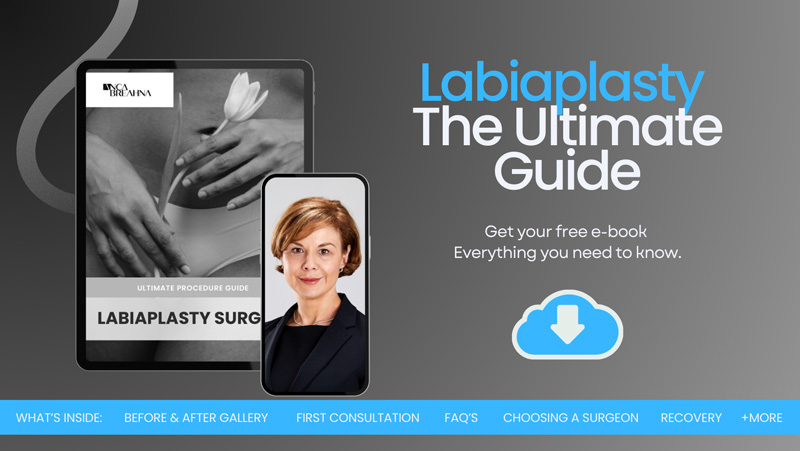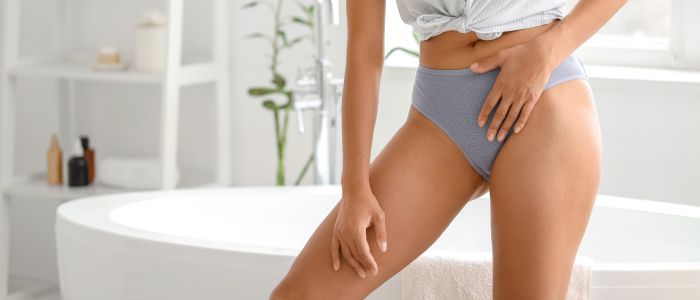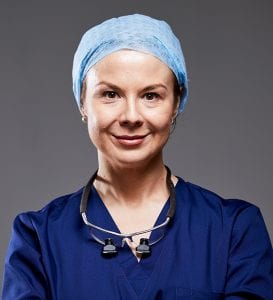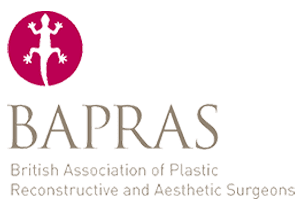
Table of Contents
- Solutions for a Sagging Vulva: Understanding Changes and Choosing the Right Treatment
- Download Anca Breahna’s Labiaplasty Guide
- Why Does the Vulva Sag Over Time?
- Concerns Associated with a Sagging Vulva
- Treatment Options for Sagging Vulva at Chester Cosmetic Surgery
- Non-Surgical Alternatives and Supportive Therapies
- What to Expect After Labiaplasty Surgery
- Frequently Asked Questions about Sagging Vulva and Labiaplasty
- In Summary
- Further Reading
Solutions for a Sagging Vulva: Understanding Changes and Choosing the Right Treatment
The vulva, comprising the external part of the female genitalia, includes two sets of protective folds known as the labia – the outer labia majora and the inner labia minora. These soft tissues serve both a protective and aesthetic function. However, as they are composed largely of skin and fatty tissue, it is entirely natural for their appearance to change over time.
One such change, often described as a sagging vulva, occurs when the tissues lose their firmness and elasticity, leading to a drooping or elongated appearance. While this is a common concern, it is important to distinguish between labial enlargement – which arises due to increased tissue volume – and sagging, which stems from a loss of skin tone and support.
Download Anca Breahna’s Labiaplasty Guide

Why Does the Vulva Sag Over Time?
The skin of the vulva, like that on other areas of the body, is susceptible to the ageing process. With time, the natural decline in collagen and elastin – the structural proteins responsible for skin firmness – can result in laxity and thinning of the labial tissues.
Other contributing factors include:
- Hormonal changes during perimenopause and menopause
- Childbirth and vaginal delivery, which may stretch and weaken the perineal and labial structures
- Frequent or high-impact physical activity, which can contribute to repetitive stress on vulval tissues
- Genetics, which influence how skin ages and responds to strain
- Weight fluctuations, which can alter the volume and tone of the area
These changes are not harmful in themselves, but many women find them physically uncomfortable or aesthetically distressing, particularly when they affect intimate confidence or cause friction during daily activities.
Concerns Associated with a Sagging Vulva
Women who experience vulval sagging may report:
- Increased visibility through tight clothing, such as activewear or swimwear
- Chafing or discomfort during exercise, cycling, or intercourse
- Changes in urinary control, such as mild stress incontinence
- Vulval irritation or dryness (atrophic vaginitis), especially post-menopause
- Reduced self-esteem or emotional discomfort related to body image
It is important to know that these concerns are not uncommon, and effective, discreet treatments are available for women who wish to address them.
Treatment Options for Sagging Vulva at Chester Cosmetic Surgery
At Chester Cosmetic Surgery, Miss Anca Breahna offers bespoke surgical solutions for women seeking relief from the physical and emotional impact of a sagging vulva. Treatment is always approached with sensitivity, dignity, and a commitment to individualised care.
Labiaplasty (Labia Majora Reduction)
For suitable candidates, a labiaplasty can offer a long-term solution to reduce excess, stretched, or sagging tissue from the labia majora. This procedure aims to:
- Restore a more youthful contour to the vulva
- Alleviate physical discomfort
- Improve aesthetic proportions
- Support psychological well-being
Performed under local or general anaesthesia, labiaplasty is typically a day case procedure, and recovery is often straightforward with proper care. The incisions are carefully placed to minimise visible scarring, and patients are given tailored aftercare instructions to optimise healing and outcomes.
Non-Surgical Alternatives and Supportive Therapies
For some women – particularly those with mild concerns or who are not ready for surgery – non-surgical treatments may offer temporary improvement. While these options do not remove excess skin, they can enhance tone and support in the vulval area:
- Radiofrequency skin tightening (e.g., FormaV or similar platforms)
- Laser therapy to stimulate collagen regeneration
- Topical oestrogen creams, in postmenopausal women with atrophic changes
- Pelvic floor physiotherapy to enhance underlying muscular support
Miss Breahna is always happy to discuss the full range of available options in a confidential consultation, ensuring that patients feel supported in making the most appropriate choice for their body and lifestyle.
What to Expect After Labiaplasty Surgery
Recovery after labiaplasty is typically smooth, but careful adherence to aftercare guidance is essential. Most women can resume light daily activities within a few days and return to normal routines, including exercise and intimacy, within 4–6 weeks.
Key recovery principles include:
- Gentle hygiene and avoiding submersion in water until fully healed
- Wearing loose, breathable underwear to reduce friction
- Avoiding high-impact activity during the early healing phase
- Monitoring for signs of infection, swelling, or discomfort
- Attending follow-up appointments to ensure proper healing
Miss Breahna provides comprehensive post-operative care, ensuring that each patient feels confident and supported throughout their recovery journey.
Frequently Asked Questions about Sagging Vulva and Labiaplasty

What is the difference between sagging labia and enlarged labia?
While both conditions may appear similar, enlarged labia typically result from increased tissue volume, often due to hormonal changes or genetics. In contrast, sagging labia refer to lax or stretched skin – usually related to ageing, childbirth, or reduced collagen in the tissue. During consultation, Miss Breahna can help assess the underlying cause and recommend the most appropriate treatment.
Is labiaplasty only cosmetic, or can it help with discomfort?
Labiaplasty is not solely cosmetic. Many women undergo the procedure to address functional concerns such as irritation, discomfort during physical activity, or visibility under clothing. By reducing stretched skin and restoring natural contour, labiaplasty can improve both comfort and self-confidence.
How long does labiaplasty surgery take?
Labiaplasty is usually a short procedure, often lasting between 45 minutes to 1.5 hours, depending on the extent of the tissue being corrected. It is typically performed as a day case, under local or general anaesthesia.
What is the recovery like after labiaplasty?
Most patients experience mild swelling and sensitivity for the first few days. With proper care, discomfort is minimal and manageable. Patients are encouraged to avoid strenuous activity and sexual intercourse for approximately 4–6 weeks. Miss Breahna provides tailored aftercare and will monitor your recovery closely during follow-up appointments.
Will there be visible scarring after labiaplasty?
Scars from labiaplasty are typically very discreet, as incisions are made along the natural contours of the labia. With good wound care and healing, most scars fade significantly over time and are barely perceptible.
Can non-surgical treatments help with sagging vulva?
Yes. For mild cases, non-surgical therapies such as radiofrequency or laser treatments may help improve skin tone by stimulating collagen production. However, these options are generally less effective for significant laxity or excess skin. Miss Breahna will advise if a non-surgical approach is suitable during your consultation.
Is it normal to feel self-conscious about changes in the vulva?
Absolutely. The vulva is a sensitive and personal area, and changes over time – whether due to ageing, childbirth, or genetics – can understandably affect a woman’s emotional wellbeing and body image. Miss Breahna’s approach is always empathetic and non-judgemental, focused on helping patients make decisions that align with their comfort, health, and confidence.
In Summary
A sagging vulva is a natural and treatable condition, and there is no need to suffer in silence. Whether the concern is cosmetic, functional, or both, a range of effective options – both surgical and non-surgical – can restore comfort, confidence, and balance.
Miss Anca Breahna brings years of specialist experience and a deeply personal approach to each consultation, helping women make empowered, informed decisions about their bodies.
If you are concerned about changes to the vulval area and wish to explore your treatment options, please contact our team to arrange a discreet consultation with Miss Breahna.
Phone: 07538 012918
Email: contact@ancabreahna.com
Further Reading
- Read Anca’s Procedure on Desirial Injections (Vaginal Dryness)
- Read Anca’s Blog on Exercise after Labiaplasty
Back to blog







